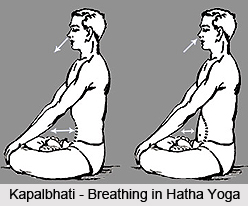 Types of breathing exercises in Hatha Yoga include three forms of breathing which are quite popularly known among the Yogis. The first is the well-known Yogi Cleansing Breath, to which is attributed much of the great lung endurance found among the Yogis. The Yogis usually finish up a breathing exercise with the Cleansing Breath. It is said that the Yogis have a favourite form of breathing which they practice when they feel the necessity of ventilating and cleansing the lungs. They conclude many of their other breathing exercises with this breath.
Types of breathing exercises in Hatha Yoga include three forms of breathing which are quite popularly known among the Yogis. The first is the well-known Yogi Cleansing Breath, to which is attributed much of the great lung endurance found among the Yogis. The Yogis usually finish up a breathing exercise with the Cleansing Breath. It is said that the Yogis have a favourite form of breathing which they practice when they feel the necessity of ventilating and cleansing the lungs. They conclude many of their other breathing exercises with this breath.
Yogi Cleansing Breath
This Cleansing Breathing ventilates and cleanses the lungs, stimulates the cells and gives a tone to the respiratory organs, and is conducive to their general healthy condition. Besides this effect, it is found to greatly refresh the entire system. The breath will be found quite refreshing when one is tired and generally used up.
Yogi Nerve Vitalizing Breath
This is an exercise well known to the Yogis, who consider it one of the strongest nerve stimulants and invigorants known to man. Its purpose is to stimulate the Nervous System, develop nerve force, energy vitality. This exercise brings a stimulating pressure to bear on important nerve centres, in turn stimulate and energize the entire system. The efficiency of this exercise depends greatly upon the speed of the drawing back of the fists, and the tension of the muscles, and, of course, upon the full lungs.
Yogi Vocal Breath
The Yogis have a form of breathing to develop the voice. They are noted for their wonderful voice which are strong, smooth and clear, and have a wonderful trumpet-like carrying power. They have practiced this particular form of breathing exercise which has resulted in rendering their voices and flexible, imparting to it that indescribable, peculiar floating quality, combined with great power.
According to Hatha Yoga these three types of breathing exercise help in the attainment of the Complete Breathing of an individual and when complete breathing is practised by an individual he is able to control his body as well as his mind in a more effective manner. This is because breathing is such an activity of all living beings that all other activities are dependant on breathing itself.




















